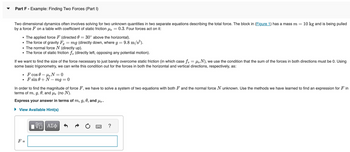Part E - Solving for Two Variables Now that you have one of the two variables in Part D isolated, use substitution to solve for the two variables. You may want to review the Multiplication and Division of Fractions and Simplifying a Expression Primers. Enter the answer as two numbers (either fraction or decimal), separated by a comma, with C first. ► View Available Hint(s) C, D= ΨΕΙ ΑΣΦ ?
Part E - Solving for Two Variables Now that you have one of the two variables in Part D isolated, use substitution to solve for the two variables. You may want to review the Multiplication and Division of Fractions and Simplifying a Expression Primers. Enter the answer as two numbers (either fraction or decimal), separated by a comma, with C first. ► View Available Hint(s) C, D= ΨΕΙ ΑΣΦ ?
Glencoe Algebra 1, Student Edition, 9780079039897, 0079039898, 2018
18th Edition
ISBN:9780079039897
Author:Carter
Publisher:Carter
Chapter6: Systems Of Linear Equations And Inequalities
Section: Chapter Questions
Problem 6SGR
Related questions
Question

Transcribed Image Text:Part E - Solving for Two Variables
Now that you have one of the two variables in Part D isolated, use substitution to solve for the two variables. You may want to review the Multiplication and Division of Fractions and Simplifying an
Expression Primers.
Enter the answer as two numbers (either fraction or decimal), separated by a comma, with C first.
► View Available Hint(s)
C, D =
Submit
ΠΫΠΙ ΑΣΦ
?

Transcribed Image Text:Part D - Isolating a Variable with a Coefficient
In some cases, neither of the two equations in the system will contain a variable with a coefficient of 1, so we must take a further step to isolate it. Let's say we now have
3C + 4D = 5
2C+ 5D = 2
●
●
None of these terms has a coefficient of 1. Instead, we'll pick the variable with the smallest coefficient and isolate it. Move the term with the lowest coefficient so that it's alone on one side of its
equation, then divide by the coefficient. Which of the following expressions would result from that process?
D = ²/3 - ²/C
-³/C
C = 1-³/D
C=-D
3
○ D =
O
Submit
5
Previous Answers
Correct
Expert Solution
This question has been solved!
Explore an expertly crafted, step-by-step solution for a thorough understanding of key concepts.
This is a popular solution!
Trending now
This is a popular solution!
Step by step
Solved in 3 steps with 10 images

Follow-up Questions
Read through expert solutions to related follow-up questions below.
Follow-up Question

Transcribed Image Text:Part F - Example: Finding Two Forces (Part I)
Two dimensional dynamics often involves solving for two unknown quantities in two separate equations describing the total force. The block in (Figure 1) has a mass m = 10 kg and is being pulled
by a force F on a table with coefficient of static friction μs 0.3. Four forces act on it:
• The applied force F (directed 0 = 30° above the horizontal).
• The force of gravity Fg = mg (directly down, where 9 =
• The normal force N (directly up).
• The force of static friction f, (directly left, opposing any potential motion).
If we want to find the size of the force necessary to just barely overcome static friction (in which case ƒ = µN), we use the condition that the sum of the forces in both directions must be 0. Using
some basic trigonometry, we can write this condition out for the forces in both the horizontal and vertical directions, respectively, as:
F cos 0 μs N=0
F sin 0+N-mg = 0
F =
In order to find the magnitude of force F, we have to solve a system of two equations with both F and the normal force N unknown. Use the methods we have learned to find an expression for Fin
terms of m, g, 0, and μs (no N).
Express your answer in terms of m, g, 0, and μs.
View Available Hint(s)
= 9.8 m/s²).
ΠΫΠΙ ΑΣΦ
?
Solution
Recommended textbooks for you

Glencoe Algebra 1, Student Edition, 9780079039897…
Algebra
ISBN:
9780079039897
Author:
Carter
Publisher:
McGraw Hill

College Algebra (MindTap Course List)
Algebra
ISBN:
9781305652231
Author:
R. David Gustafson, Jeff Hughes
Publisher:
Cengage Learning

College Algebra
Algebra
ISBN:
9781305115545
Author:
James Stewart, Lothar Redlin, Saleem Watson
Publisher:
Cengage Learning

Glencoe Algebra 1, Student Edition, 9780079039897…
Algebra
ISBN:
9780079039897
Author:
Carter
Publisher:
McGraw Hill

College Algebra (MindTap Course List)
Algebra
ISBN:
9781305652231
Author:
R. David Gustafson, Jeff Hughes
Publisher:
Cengage Learning

College Algebra
Algebra
ISBN:
9781305115545
Author:
James Stewart, Lothar Redlin, Saleem Watson
Publisher:
Cengage Learning

Algebra & Trigonometry with Analytic Geometry
Algebra
ISBN:
9781133382119
Author:
Swokowski
Publisher:
Cengage

Algebra: Structure And Method, Book 1
Algebra
ISBN:
9780395977224
Author:
Richard G. Brown, Mary P. Dolciani, Robert H. Sorgenfrey, William L. Cole
Publisher:
McDougal Littell

Holt Mcdougal Larson Pre-algebra: Student Edition…
Algebra
ISBN:
9780547587776
Author:
HOLT MCDOUGAL
Publisher:
HOLT MCDOUGAL